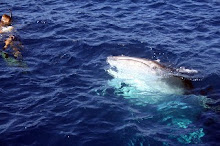And have been seen every morning and afternoon for the past four days.

Whenever we go out looking for sharks, I always tell the people on the boat that there are two
 golden rules for interacting with whale sharks. For such a large creature, they are remarkably skittish. A whole group of snorkelers jumping into the water is often plenty to send the shark off into deeper waters.
golden rules for interacting with whale sharks. For such a large creature, they are remarkably skittish. A whole group of snorkelers jumping into the water is often plenty to send the shark off into deeper waters.Golden rule number one: Don't splash.
We slide into the water, keep our fin strokes in the water, and never, never, use our arms to swim (the last point is a sure way to get the sharks to dive).
Golden rule number two: If the shark can see you: FREEZE
We always try to stay at least 10ft from the shark (13ft from the tail) but what we have found is that if the shark can see people then it is much more disturbed by movement than by proximity. So when we are in the water, the whole group freezes whenever there is a shark nearby.
 It is remarkable how well these encounter guidelines work. On Monday we had a seies of incredible encounters with whale sharks where, after a couple of swims, the
It is remarkable how well these encounter guidelines work. On Monday we had a seies of incredible encounters with whale sharks where, after a couple of swims, the  shark got accustomed to us and started to approach us and investigate us. WOW. This type of encounter minimises our disturbance of the shark and certainly makes for life-changing encounters.
shark got accustomed to us and started to approach us and investigate us. WOW. This type of encounter minimises our disturbance of the shark and certainly makes for life-changing encounters.Having said all of this, it is important that I emphasise just how special such encounters are. We never harass the whale sharks and we never let people swim up close to the sharks. If you have the honour of having one of these beautiful animals approach you, please remember to respect it and treat it like a wild animal: don't reach out to touch it and allow it to swim away when it moves off.

No comments:
Post a Comment